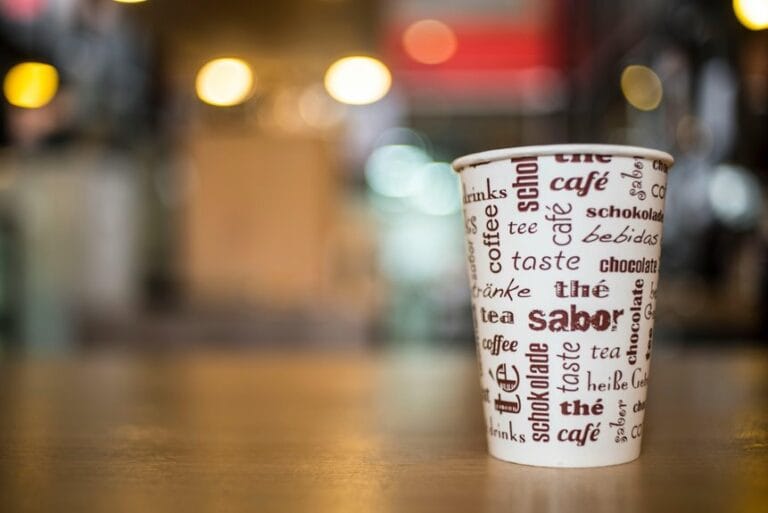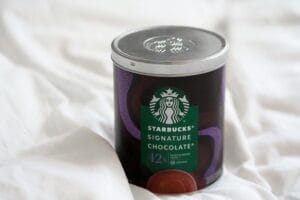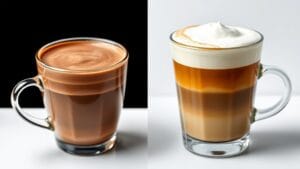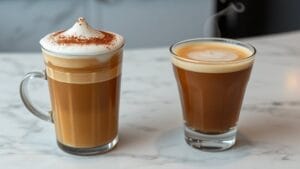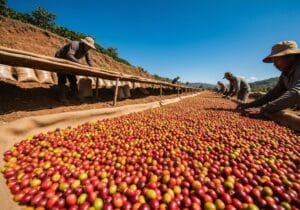Mocha and frappe come from different worlds: mocha’s roots lie in Yemen’s ancient coffee trade, blending espresso with chocolate for deep, cozy richness, while the frappe was born in 1950s Greece as a chilled, frothy mix of instant coffee, ice, and sugar. Mocha tastes like dessert in a cup—warm and chocolatey—while frappe is a sweet, icy shake, lighter and bubblier. One packs more caffeine (hello, espresso!), the other leans on instant coffee crunchy texture. Their prep? Think steaming versus shaking, cocoa powder versus milkshake vibes. Craving heat or frost? Coffee traditions clash deliciously here—dig deeper to pick your side!
Origins and Historical Background

Coffee’s history is packed with stories, like how mocha got its name from a busy port city in Yemen, where beans with a chocolatey flavor were shipped around the world for centuries. Yemen became the global epicenter of coffee cultivation and commerce. This distinctive quality of Yemeni coffee has influenced the flavor profiles of many coffee drinks.
Mocha beans were so prized, traders braved deserts and seas to share them, leading Europeans to mix chocolate with coffee, creating the modern mocha drink.
Coveted mocha beans spurred perilous trades across deserts and seas, birthing the rich coffee-chocolate blend savored globally today.
Frappes, however, are way younger—born in 1950s Greece when someone accidentally mixed instant coffee, ice, and sugar, making a frothy, icy treat perfect for hot days. The original Greek frappe relied on instant coffee, which dissolves easily in cold water, while mochas use espresso for their base.
While mocha vs frappe highlights centuries-old trade vs mid-century creativity, mocha vs frappuccino? That’s easy: Frappuccino is Starbucks’ trademarked take, blending frappe textures with cappuccino vibes.
Both drinks carry their roots like flavor badges—mocha whispers ancient markets, while frappe screams beachside sipping. Who knew a Yemeni bean and a Greek accident could spark global obsessions?
Core Ingredients and Their Composition

Mocha starts with rich espresso and melted chocolate, giving it a bold coffee-chocolate kick, while frappes blend instant coffee with ice for a frosty, milkshake-like base.
Sweeteners like sugar, syrups, or whipped cream add layers of sweetness to both drinks, though mochas lean on chocolate’s natural richness, and frappes often pack an extra sugary punch. The Mocha Frappé’s base includes high fructose corn syrup as a key ingredient, contributing to its 430-calorie profile and heightened sweetness.
While mochas stick to steamed milk for creaminess, frappes sometimes swap in almond or oat milk, making them lighter and friendlier for different diets.
Coffee Base Variation
Mocha leans on espresso or strong brewed coffee for its bold, intense flavor, mixed with cocoa powder or chocolate syrup to create that rich, chocolatey kick. The roasting process critically enhances the flavor profile, as well as milk softening the bitterness, adding creamy smoothness, while whipped cream enhances luxury. Moreover, espresso’s characteristics such as its thick, golden crema contribute to the overall sensory experience of a mocha.
Frappes swap espresso for instant coffee, blended with ice, cold water, or milk to form a frosty, slush-like texture. Traditional sugar levels like *sketos* (unsweetened), *metrios* (medium), and *glykos* (sweet) were standardized in the original Greek recipe, allowing drinkers to customize sweetness long before modern espresso variations. Ice isn’t just an add-on here—it’s essential, turning the drink into a chilly, sippable treat.
Even when called a “mocha frappe,” commercial versions might hide coffee extract, powders, and stabilizers to mimic that classic vibe.
Sweetener Types Used
Sugar steps into the spotlight when crafting mochas and frappes, but these drinks take sweetening in totally different directions. Mochas lean on classic sugars like granulated white sugar or syrups, blending them with cocoa for rich, chocolatey depth—some swap in erythritol for a lighter, natural twist.
Frappes shout sweetness with powders packed with dextrose or maltodextrin, creating a sugary rush, while sugar-free hacks use aspartame to dodge calories. Homemade mochas might sneak in vanilla extract for subtle sweetness, but frappes? They’re like sugar playgrounds: traditional versions let you dump in extra spoonfuls, and store-bought mixes pile on processed sweeteners.
Mochas balance espresso’s bitterness with smooth sucrose, while frappes go big—thicker, sweeter, bolder. Choose your fighter: chocolate harmony or icy sugar blast!
Milk and Milk Alternatives
At the heart of every creamy coffee drink lies its milky backbone, the fluffy, frothy, or icy foundation that turns simple ingredients into something magical.
Mochas rely on steamed dairy milk for warmth and creaminess, blending espresso with chocolate for a cozy, indulgent sip packed with about half a cup of milk per serving.
Frappes, though, swap heat for ice, blending cold milk (or almond, oat, or soy alternatives) with instant coffee and sugar, resulting in a frosty, almost milkshake-like texture.
Steamed milk in mochas adds richness and a touch of silky fat, but frappes often use lighter or plant-based milks, cutting calories while keeping things invigorating.
Both drinks cater to freedom of choice—whether craving dairy’s comfort or a cool, customizable dairy-free treat. Additionally, coffee drinks may help provide benefits like increased alertness, thanks to their caffeine content.
Flavor Profiles: Chocolate Depth vs. Refreshing Sweetness

When the craving for coffee strikes, mocha and frappe step up like flavor superheroes—but they swing from opposite poles!
When coffee cravings hit, mocha and frappe clash as rival titans—flavor warriors duking it out from opposite ends of the caffeine cosmos!
Mocha packs a punch with its rich chocolate and bold espresso, blending bitter coffee depth with velvety sweetness. Frappe leans into icy refreshment, mixing milder coffee, sugar, and frosty textures for a sugary, chill vibe.
- Chocolate Showdown – Mocha layers espresso with cocoa for a *warm, intense indulge-fest*; frappe skimps on chocolate, prioritizing sweet syrups like caramel.
- Sweetness Balance – Mocha marries bitter and sweet; frappe screams “sugar rush” with icy, candy-like flavors.
- Temperature Drama – Mocha wraps you in cozy warmth; frappe slaps you awake with frosty, milkshake vibes.
- Mood Match – Craving a dessert-like treat? Mocha. Need a poolside sip? Frappe’s your chill sidekick.
Texture and Mouthfeel Contrasts
A mocha feels creamy and smooth, mixing coffee and chocolate like a thick, warm blanket, while a frappe is icy and frosty, like a coffee-flavored snow whirl.
The mocha gets its fluffy, frothy top from whipped cream or steamed milk, but a frappe’s slushy texture comes from blending ice until it’s almost like a drinkable coffee slushie.
Sip a mocha for velvety richness that stays silky, or try a frappe for crunchy ice bits that melt into a cool, grainy rush with every gulp.
Creamy Vs Icy Consistency
The magic of coffee lies in its textures, where creamy mochas and icy frappes battle for the spotlight!
- Hot vs. Cold: Mocha’s warmth keeps its steamed milk and chocolate syrup velvety-smooth, like melted ice cream, while frappes blend ice into a frosty, crunchy slush that’s perfect for beating the heat.
- Density Drama: Mocha feels heavy and rich, clinging to your tongue with chocolatey decadence, but frappes skip the heft, swapping thickness for light, airy swirls of icy refreshment.
- Fat vs. Frost: Steamed milk in mochas melts fats into silkiness, whereas frappes use ice to dilute creaminess, creating a cool, watery zing that dances on the palate.
- Sweet Trickery: Heat amplifies sugar in mochas, making every sip feel indulgent, but frappes tame sweetness with chilly vibes, balancing sugary sips with crisp frostiness.
Froth Vs Slush Texture
Froth and slush, coffee’s ultimate texture rivals, take center stage in every sip!
Mocha’s froth, born from steamed milk aeration, is like a velvety cloud: thick, smooth, and creamy, sitting proudly atop rich espresso-chocolate bliss. It hugs the drink, keeping it warm, while its tiny bubbles deliver a silky, luxurious feel. The preparation process for mocha often involves careful temperature control, which enhances the overall richness of the beverage.
Frappe’s froth plays a different game—shaken or blended into icy chaos, it’s airy, bubbly, and light, like a foam party on a frozen coffee base.
Then comes the slush: crushed ice mingling with coffee, sugar, and milk, creating a crunchy, frosty avalanche that chills the tongue. Froth whispers warmth and richness; slush shouts icy refreshment.
One’s a cozy blanket, the other a snowball fight—each claiming its throne in the texture showdown! Interestingly, the pressure used during espresso extraction, such as the optimal 9 bars of pressure, significantly influences the richness of the mocha’s frothy layer.
Smooth Vs Grained Mouthfeel
Coffee’s texture wars pit two rivals: a velvety caress versus an icy crunch. Mocha wraps the tongue in silky warmth, blending steamed milk and chocolate for a pillowy ride, while frappe smashes ice into frosty confetti, delivering a brain-freeze slurpee vibe.
Let’s break it down:
- Temperature Tricks: Mocha’s cozy steam melts chocolate into a liquid hug, but frappe blasts ice chunks for a polar plunge.
- Texture Titans: Mocha’s steamed milk makes it smooth as a jazz tune; frappe’s crushed ice roughs it up like a punk-rock beat.
- Toppings Tell All: Whipped cream on mocha? Extra fluff. On frappe? A fluffy hat on a snowman—sweet, but the crunch stays.
- Feel the Funk: Mocha coats your mouth like melted velvet, while frappe dances with crunchy ice beads, leaving a frosty high-five.
Choose your fighter: soft clouds or icy rebellion.
Preparation Methods and Techniques
Mastering coffee drinks starts with how they’re made, and methods vary wildly. A classic Greek frappe gets its signature foam by shaking instant coffee, sugar, and cold water hard for 30 moments, creating thick froth layered over ice, milk, and water.
Mocha, meanwhile, starts with espresso blended with chocolate syrup or cocoa powder, then steamed milk swirls in for creaminess, often topped with whipped cream.
While frappes depend on manual shaking for texture, mochas mix ingredients smoothly.
For icy blends like mocha frappes, blenders crush coffee, milk, and ice into slushy consistency, adding syrups or whipped cream.
Frappes celebrate simple tools and airy layers, while mochas rely on espresso machines and blending tricks—different vibes, different vibes.
Caffeine Content and Strength Variations
While mocha and frappe might both look fancy in a coffee shop display, their caffeine kicks are as different as hot chocolate and a snow cone!
- Espresso vs. Ice Showdown: A hot mocha packs espresso shots (up to 200mg caffeine in large sizes), while frappes blend ice and milk, diluting caffeine. Feel that coffee punch? Thank espresso!
- Chocolate’s Sneaky Caffeine: Mochas use dark chocolate sauce for a small caffeine enhancement, like adding sprinkles to a cupcake. Some frappes skip coffee entirely, swapping in decaf or fruit—talk about a fake-out!
- Size Matters, Folks: Order a large mocha? That’s double espresso strength! Grande frappes creep to 100mg caffeine, but ice steals the spotlight—hydration plus a buzz? Maybe.
- Instant Coffee Secret: Frappes often use instant coffee (milder caffeine), perfect for sipping slowly. Need a jolt? Mocha’s your sleepy-morning hero. Also, the caffeine content in both beverages can vary greatly depending on the espresso shots used and preparation methods.
Cultural Context and Global Adaptations
Mocha and frappe began their journeys in wildly different places, one in Yemen’s bustling 15th-century coffee trade and the other in a 1950s Greek experiment, but today they’re sipped worldwide, blending old traditions with new twists.
Mocha nods to Yemen’s historic coffee roots, where traders spilled beans and chocolate-like flavors into Europe, later refined in Italy’s bicerin drink—layered with coffee, chocolate, and cream.
From Yemen’s ancient coffee roots, mocha’s bold chocolate notes sailed to Europe, evolving into Italy’s indulgent bicerin of coffee, chocolate, and cream.
Frappe captures Greece’s sun-soaked vibe, born from instant coffee shaken with ice, inspiring chilled sips from beaches to bustling cities.
Globally, mocha morphs into mochaccinos or spiced Middle Eastern mixes, while frappes flirt with milkshakes and foam-topped lattes.
Chains like Starbucks tweak sweetness, milks, even flavors, proving coffee’s power to bridge cultures, one frosty or frothy cup at a time.
Frequently Asked Questions
Do Frappés Traditionally Include Ice Cream?
Traditional Greek frappés do not include ice cream. Originating in 1957, they consist of instant coffee, water, and optional sugar or milk, achieving froth through shaking. Ice cream appears in modern, dessert-style adaptations departing from the original recipe.
Can Mochas and Frappés Be Prepared With Non-Dairy Milk?
Mochas and frappés can be prepared with non-dairy milk like almond, coconut, oat, or soy. These substitutes alter texture and sweetness slightly but maintain core flavors, accommodating dietary preferences without compromising structural integrity.
Which Beverage Typically Has More Calories, a Mocha or a Frappe?
Calorie content varies by preparation, but frappes often exceed mochas due to added sugars and ice cream-like bases. Commercial frappés (e.g., Starbucks) can reach 400-660 calories, while mochas average 150-170 calories without toppings.
Is It Possible to Make a Frappé Without a Blender?
A frappé can be made without a blender using traditional methods like shaking instant coffee, sugar, and water in a sealed container. Tools like a cocktail shaker or jar create foam, followed by ice and optional milk.
Are There Decaffeinated Versions of Mocha and Frappé?
Decaffeinated mocha and frappe options exist. Mocha uses decaf espresso, retaining chocolate and milk, while decaf frappes replace regular coffee with decaf instant or espresso. Cafes often provide these for caffeine-conscious consumers seeking similar flavor experiences.

